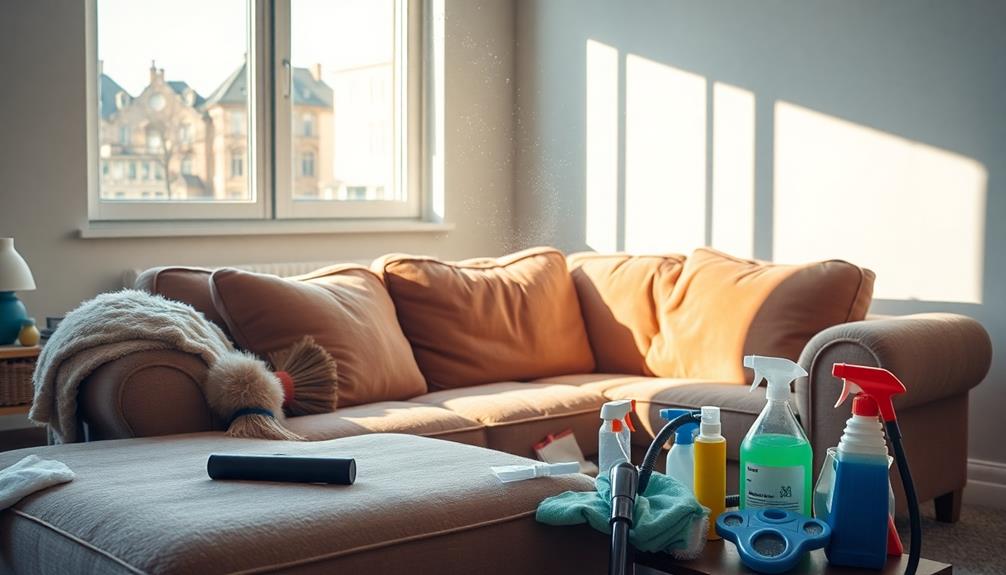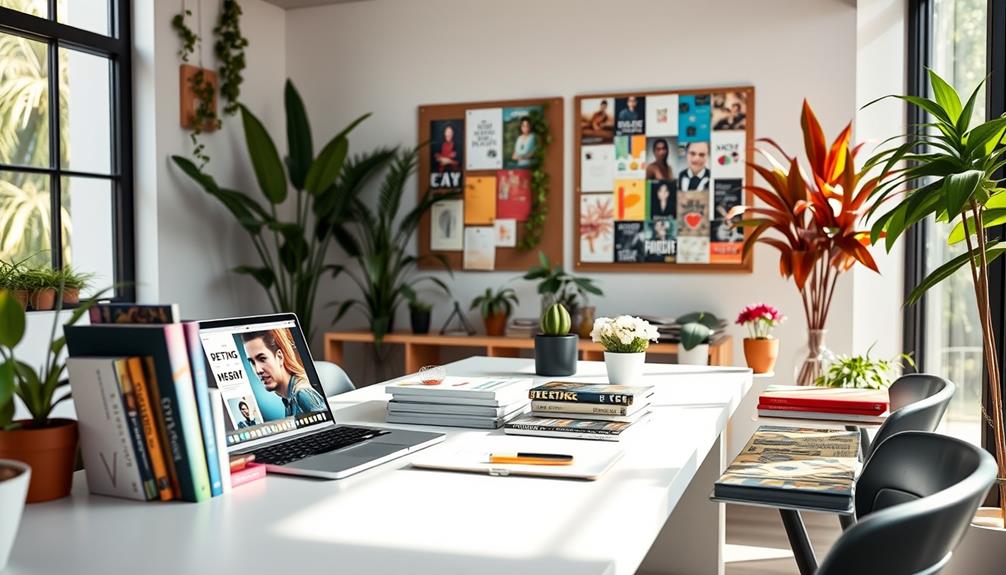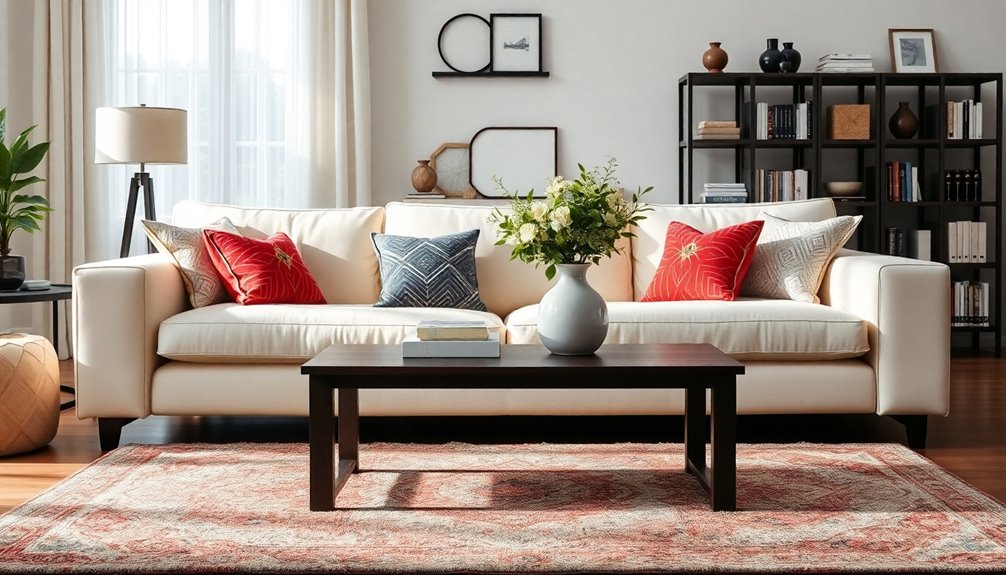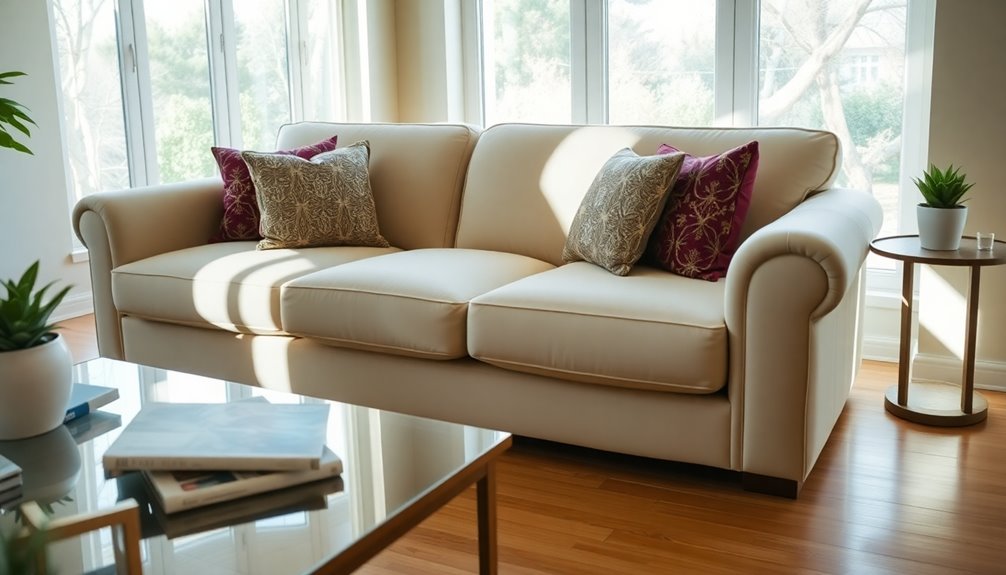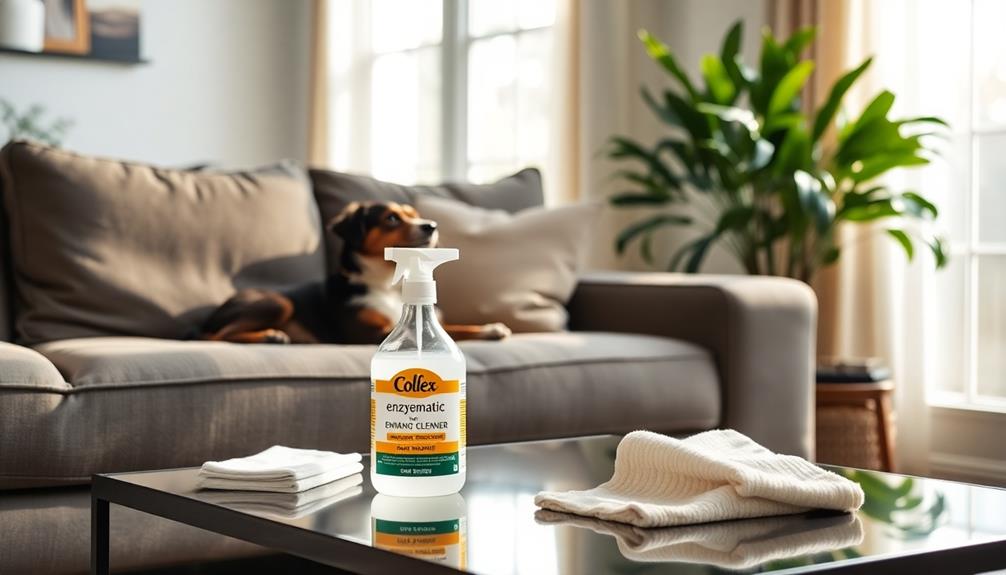To effectively clean your sofa, begin by checking the care tag for fabric instructions. Gather cleaning supplies like a vacuum with upholstery attachments, a mild cleaning solution, and baking soda. Vacuum thoroughly, paying close attention to all crevices and under cushions to remove dust and allergens. For stains, blot the area immediately with a clean cloth and use a gentle cleaning solution appropriate for your sofa’s fabric. Deodorize by sprinkling baking soda and allowing it to sit. Regular maintenance, such as vacuuming every couple of weeks, will help your sofa stay fresh. There is more to learn about maintaining your furniture in top condition!
Key Takeaways
- Check the care tag for fabric-specific cleaning codes to choose the right cleaning method for your sofa.
- Vacuum thoroughly with an upholstery attachment at least once a week to remove dust, crumbs, and allergens.
- Spot clean stains immediately using blotting techniques and appropriate DIY solutions for different fabric types.
- Deodorize your sofa by sprinkling baking soda, letting it sit, then vacuuming to absorb odors effectively.
- Perform a deep clean every 12 to 18 months to maintain the sofa's appearance and longevity.
Assess Your Sofa's Fabric
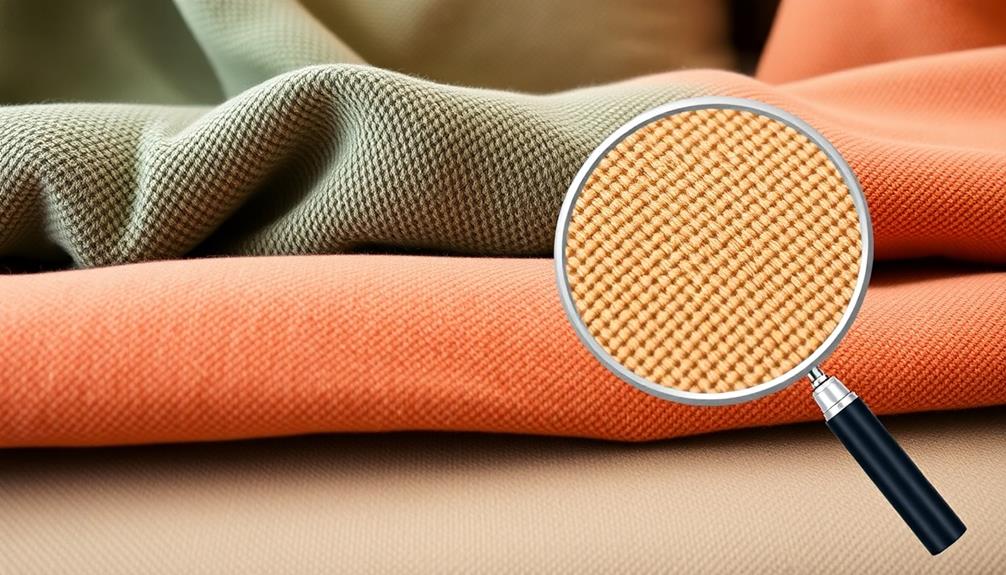
Before diving into cleaning your sofa, it's vital to evaluate its fabric type. Start by checking the care tag, which contains important cleaning codes that indicate the appropriate cleaning methods. The codes can tell you if your upholstery is a "W" for water-based cleaners, "S" for solvent-based cleaners, "W/S" for either, or "X" for vacuuming only.
Each type of fabric requires a different cleaning method, so identifying the type of fabric is essential to avoid damage. For effective dust removal, consider using vacuums equipped with HEPA filters, as they're designed to trap allergens and particles, ensuring a cleaner environment best vacuums for dust removal.
For example, if your fabric couch has a "W" label, you can safely use water and mild detergent solutions. On the other hand, an "S" code means you'll need dry-cleaning solvents. Understanding these cleaning codes helps prevent issues like color fading or shrinkage, ensuring your sofa remains in great condition.
If you can't identify the fabric type, it's wise to perform a spot test with any cleaning solution on a hidden area first. This precaution will help you check for any adverse reactions before applying the cleaner to the entire surface.
Gather Cleaning Supplies

Gathering the right cleaning supplies is essential for effectively tackling your sofa. Start by collecting a vacuum cleaner with upholstery attachments to remove debris and dust.
In addition to cleaning, it's important to maintain your furniture's value, which can be influenced by proper care and handling, similar to how budget management can affect financial health. You'll also need microfiber cloths for wiping surfaces and a soft brush to loosen any stubborn dirt.
Next, prepare a cleaning solution using 1/2 litre of warm water, 1 tablespoon of dish soap, and 1 tablespoon of baking soda. This mixture works well on fabric sofas. If your sofa has specific fabric codes, make sure to have the appropriate cleaners on hand—water-based for W-coded fabrics or solvent-based for S-coded fabrics. Before cleaning, always test the solution on a small, inconspicuous area to ensure it won’t damage the fabric. For tougher stains or lingering odors, sprinkle baking soda directly onto the sofa and let it sit for 15-20 minutes before vacuuming it up. This step, combined with the cleaning sofa with baking soda approach, can leave your furniture looking and smelling refreshed.
Don't forget to include odor neutralizers like baking soda or fabric sprays to eliminate any lingering smells. To protect your hands, grab a pair of rubber gloves.
Vacuum Thoroughly
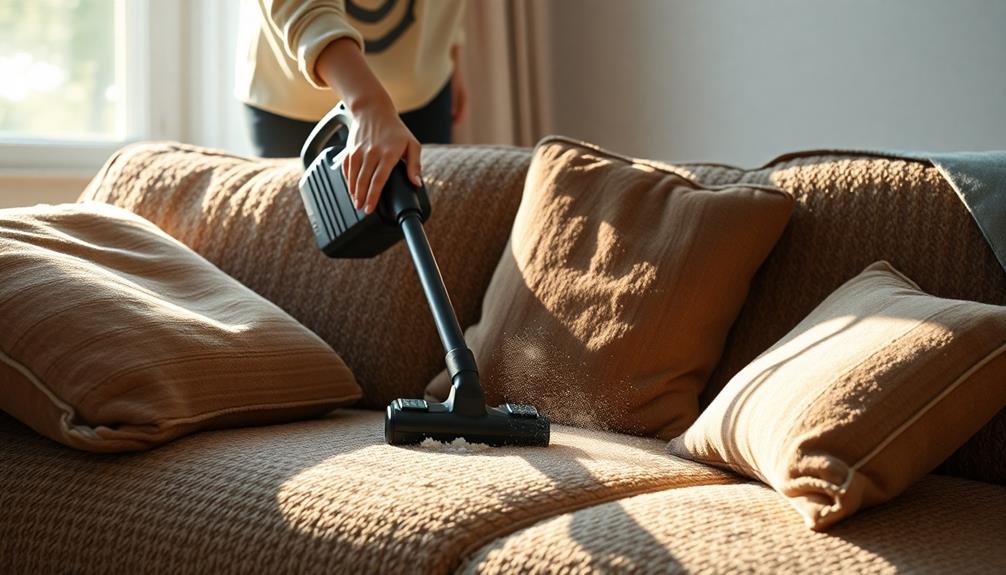
Regular vacuuming is key to keeping your sofa looking great and lasting longer.
For pet owners, it's especially important to manage pet hair and dander, which can affect indoor air quality. Use an upholstery attachment to tackle dust, crumbs, and pet hair, and don't forget to get under the cushions.
By focusing on seams and edges, you'll guarantee a thorough clean that also improves your indoor air quality.
Additionally, keeping your sofa clean can help prevent health issues related to allergens, similar to how proper hamster care involves routine cleaning to prevent disease routine health checks.
Importance of Regular Vacuuming
Keeping your sofa clean is essential, and vacuuming it thoroughly should be a key part of your routine. Regular cleaning not only helps maintain a clean appearance but also plays a significant role in prolonging the life of your upholstery. Dust, crumbs, and allergens can quickly accumulate on your upholstered furniture, and vacuuming is the most effective way to remove them.
Additionally, consider the impact of allergens on your health, as regular cleaning can improve indoor air quality, especially in homes with pets or high foot traffic. This is particularly important during cold and allergy seasons when you might be more susceptible to respiratory issues related to common cold medications.
If you have pets, regular vacuuming is vital for removing pet hair that can cling to fabric, making your sofa look unkempt. Aim to vacuum at least once a week, or more often if your home sees high foot traffic or furry friends. This practice improves indoor air quality, ensuring you breathe easier in your living space.
For thorough cleaning, don't forget to lift and vacuum both sides of loose cushions. This step prevents dirt buildup, which can lead to more significant issues down the line.
Utilizing a handheld vacuum or a brush attachment designed for upholstery will help you capture debris from those hard-to-reach spots. By incorporating vacuuming into your routine, you enhance your sofa's cleanliness and overall hygiene of your home.
Techniques for Effective Vacuuming
To maintain a spotless sofa, mastering effective vacuuming techniques is key. Start by using a vacuum with an upholstery attachment, designed specifically to remove dust, crumbs, and pet hair from the surface of your sofa.
Regular vacuuming is essential for maintaining a healthy home, as it helps reduce allergens in your living space, similar to how air purifiers enhance indoor air quality. Make sure to pay special attention to the crevices, seams, and areas under the cushions, as these spots often hide debris that can compromise the cleanliness of your upholstery.
For ideal results, vacuum your sofa at least once every few weeks to prevent dirt and allergens from building up. This regular routine not only enhances the appearance of your sofa but also extends the life of your upholstery by reducing wear and tear.
If your sofa has removable cushions, don't forget to vacuum both sides and the area underneath for a thorough cleaning.
Lastly, consider adjusting your vacuum's suction power if it's too strong, as this can damage delicate fabrics. By employing these techniques, you'll keep your sofa looking fresh and inviting while ensuring a healthier living environment for you and your family.
Happy vacuuming!
Spot Clean Stains
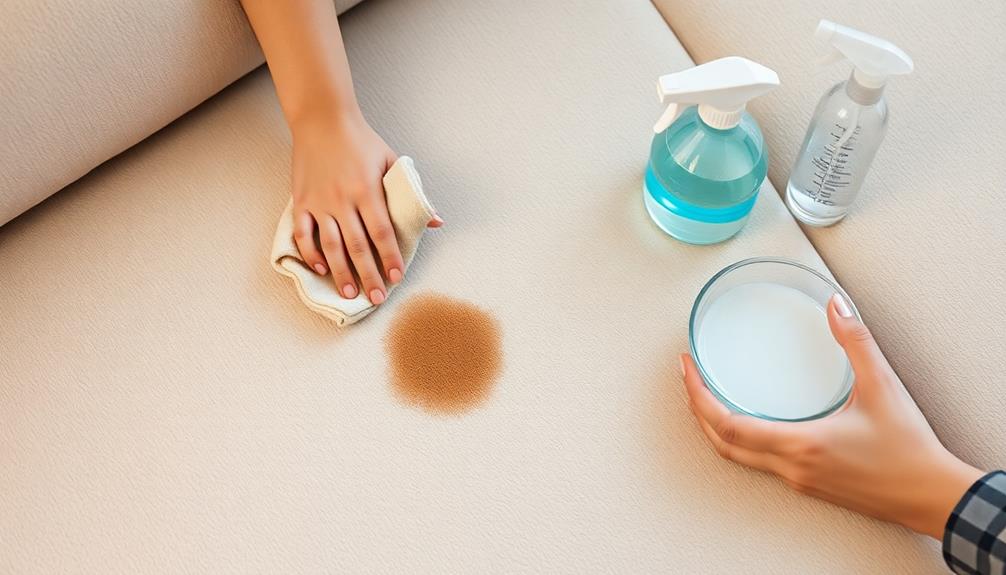
When a spill happens, act fast by blotting it with an absorbent cloth to stop stains from setting.
Utilizing effective cleaning methods can enhance the longevity of your furniture, similar to how the presence of security systems deters potential threats to your home.
Depending on your sofa's fabric, you might need a specific cleaning solution for effective treatment.
Immediate Stain Treatment
Spills happen, and acting quickly is key to preventing stains on your sofa. The first step is to blot the stain immediately with an absorbent cloth. Apply gentle pressure without rubbing, as this lifts the liquid without spreading it.
For more persistent stains, you might consider the same approach used in professional carpet cleaning methods that effectively tackle tough spots. If the stain persists, mix a DIY cleaner using equal parts of white vinegar and clean water, adding a few drops of dish soap. Use a soft cloth to apply the solution directly to the stained area.
Before using any cleaning solution, always test with the solution on a hidden area of the fabric to verify it won't cause discoloration or damage. For those stubborn stains, enzyme-based cleaners can be highly effective, especially for organic stains like food or pet accidents. Be sure to follow the manufacturer's instructions for the best results.
After cleaning, let the area air dry completely. This step is essential to prevent mildew from forming and to eliminate any lingering odors.
Fabric-Specific Solutions
Cleaning your fabric sofa requires tailored solutions for effective stain removal. Start by mixing equal parts of white vinegar, water, and mild dish soap. Gently dab the stained area with a cloth soaked in this solution. Always test it on a hidden section of your fabric first to avoid discoloration.
For stubborn stains on microfiber couches, using rubbing alcohol in a spray bottle can work wonders. Lightly apply it and scrub with a soft brush to lift the stain effectively. For maintaining a clean sofa, consider using high suction power vacuums designed for pet hair, which can help in regular upkeep.
If you encounter tough stains, consider a baking soda and water mixture. Apply it directly to the stain, let it sit for 15 minutes, then vacuum the area to remove stains.
Additionally, for specific stains like food or pet accidents, you should use a fabric-specific stain remover. Enzyme cleaners are particularly effective for these types of stains. Just be sure to follow the instructions on the product label for the best results.
Blotting Techniques Explained
In the event of a spill, quick action with effective blotting techniques can make all the difference in preserving your sofa's appearance. Start by grabbing an absorbent cloth or paper towel and gently press down on the stain. Remember, rubbing can spread the stain further, so focus on blotting. Always work from the outside of the stain toward the center to contain the damage.
If you're dealing with a particularly stubborn stain, consider using a solution with a few drops of essential oils for stain treatment to help lift the mark.
Here are some essential tips for successful blotting:
- Use a clean section of the cloth frequently to avoid reapplying the absorbed stain.
- Mix a solution of water and dish soap or use a specialty upholstery cleaner.
- Apply the cleaning solution to the cloth, not directly on the fabric, to prevent over-saturation.
- Blot the stain gently with the solution, allowing it to lift the stain without soaking the fabric.
- After treating the area, let it air dry completely before using the sofa, as damp fabric can attract dirt and lead to further staining.
Deodorize the Sofa
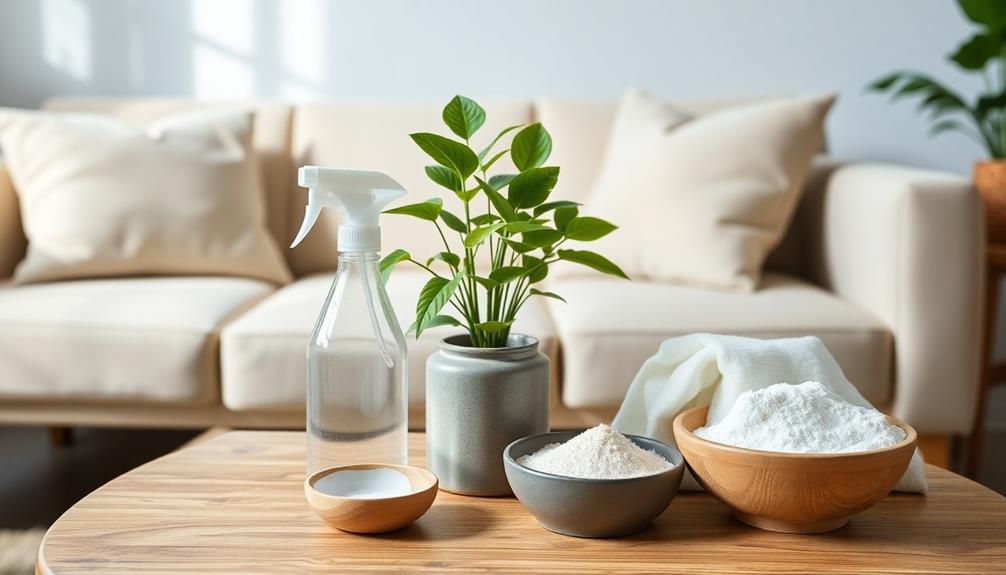
A fresh-smelling sofa can make all the difference in your living space. To deodorize your sofa effectively, start by sprinkling baking soda generously over the entire surface. Let it sit for at least 15 minutes; this allows the baking soda to absorb odors, leaving your upholstery fresher.
Additionally, if you have pets, be mindful that certain cleaning products can be harmful to them, so consider using pet-friendly cleaning options when deodorizing. Afterward, vacuum it up thoroughly, including under the cushions, to remove any debris and prevent odors from settling in.
If your sofa has stubborn pet odors, consider using enzymatic cleaners specifically designed to break down organic stains and smells. These cleaners effectively tackle the source of the odors, ensuring a thorough deodorization.
You can also use a fabric spray, like Febreze FABRIC, to neutralize any lingering smells. Just spray lightly over the upholstery and allow it to dry.
Incorporating a routine of deodorizing your sofa every six months will help maintain a fresh and clean living environment. By taking these steps, you can enjoy a sofa that not only looks great but smells inviting too!
Maintain Regular Cleaning
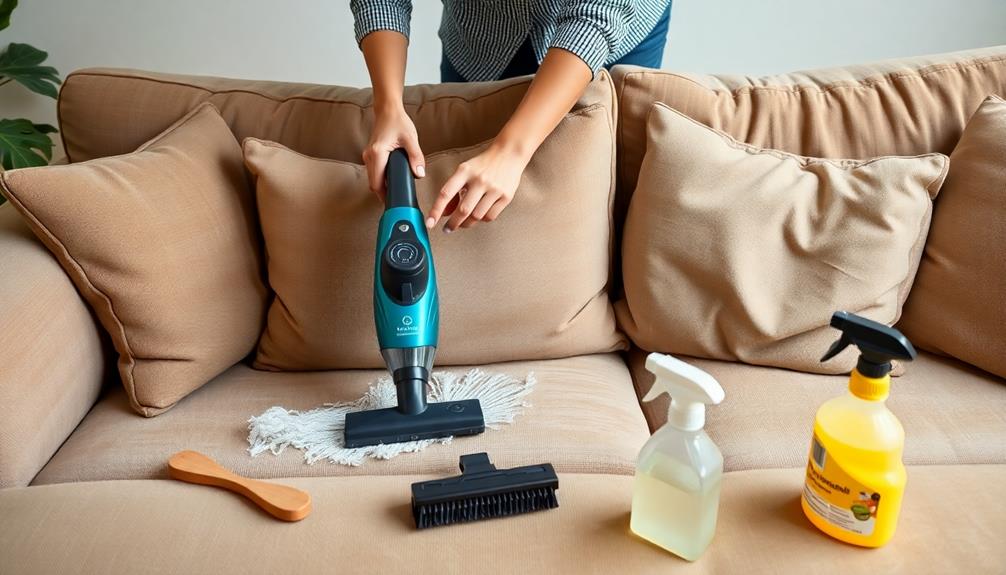
Regularly maintaining your sofa is essential for keeping it looking and feeling its best.
By incorporating a few simple habits into your routine, you can prolong the life of your couch and keep it fresh.
Here are some quick and easy tips to follow on a regular basis:
- Vacuum your sofa every 1 to 2 weeks to eliminate dust, crumbs, and pet hair.
- Fluff and rotate cushions every few weeks to maintain their shape and prevent uneven wear.
- Spot clean any spills immediately with an appropriate cleaner to avoid permanent pet stains.
- Consider a deeper clean every 12 to 18 months, or more often if you have pets or high-traffic areas.
- Use a lint roller or handheld vacuum for quick clean-ups of small debris between thorough cleanings.
Frequently Asked Questions
How Can I Clean My Sofa Fabric?
To clean your sofa fabric, check the care tag first. Then, mix warm water, dish soap, and baking soda. Blot spills immediately, vacuum regularly, and consider deep cleaning with a steam cleaner for a thorough refresh.
What Is the Best Way to Clean a Couch?
Cleaning your couch can be a delightful experience! Start by identifying the fabric, then gently scrub with a warm water and soap mix. Regular vacuuming keeps it fresh, while prompt blotting saves the day from spills!
How Do You Clean and Deodorize a Couch?
To clean and deodorize your couch, start by vacuuming thoroughly. Use a vinegar-water solution for stains, sprinkle baking soda for odors, and always check the care tag for safe cleaning methods. Enjoy your refreshed couch!
Can You Clean a Couch With Soap and Water?
Yes, you can clean a couch with soap and water. Just mix mild dish soap with warm water, test it on a hidden area first, and use a damp cloth to apply. Rinse frequently!
Conclusion
Cleaning your sofa doesn't have to be an intimidating task. With regular maintenance and a few simple steps, you can keep it looking fresh and inviting. Remember, "A stitch in time saves nine." By addressing stains and odors promptly, you'll prevent bigger issues down the road. So, take a little time now to care for your sofa, and it'll reward you with comfort and style for years to come. Happy cleaning!
